| It
is already known that the hydrogen and oxygen atoms by themselves may
take on electrical charges. But until now, no one discovered that by
simultaneously exposing the water molecule to one positively charged and
one negatively charged electrical voltage zone, the unlike hydrogen and
oxygen atoms assume opposing electrical characteristics, equal in
magnitude and potential, thereby stabilizing the electrical polarity of
the water molecule into existence. In the water molecule, the two
hydrogen atoms take on a positive (+) electrical charge and the one
oxygen atom takes on a negative (-) electrical charge, thereby
satisfying the two basic laws of physics... for every action there is an
equal and opposite reaction, and that all things must reach a stable
state.
Although the molecule is stabilized in electrical polarity by the
simultaneous application of the two oppositely charged voltage zones,
the bond between its atoms is greatly weakened in this process. The
positively charged hydrogen atoms are attracted to the negatively
charged voltage zone, and the negatively charged oxygen atoms are
attracted to the positively charged voltage zone... satisfying the
opposite polarity attraction law of physics.
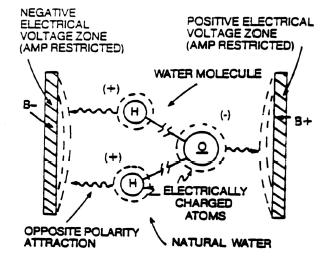 Electrical
Polarization Process Electrical
Polarization Process
Simply, the electrical polarization of the water molecule is basically a
four step process.
- First, oppositely charged electrical voltage zones are
simultaneously introduced to either side of the water molecule.
- Secondly, the water molecule becomes electrically polarized
(electrically charged).
- Thirdly, this electrical polarization of the hydrogen and oxygen
atoms greatly weakens the stability of the water molecule.
- Finally, because the voltage zones are still present with their
opposite electrical attractions, the water molecule is split into
its component parts. The hydrogen and oxygen atoms separate, with
the hydrogen being attracted to the negative electrical voltage
zone, while the oxygen is attracted to the positive electrical
voltage zone... all simultaneously.
Covalent Break-up of the Water Molecule
In scientific terms, once the electrical polarization process occurs,
the covalent bonding or sharing of electrons between atoms of the water
molecule ceases to exist since the positive electrically charged
hydrogen atoms attract the free floating negative charged electrons;
while, at the same time, the negatively electrically charged oxygen atom
repels the moving electron.... thereby stabilizing the energy level of
the atoms... separating the water molecule into its component parts....
releasing energy in the form of hydrogen gas and oxygen gas. The
opposite polarity attraction that now exists between the liberated
electrically charged atoms and the stationary electrical voltage zones
further aids the splitting process. The repetitive pulse voltage
frequency potential, or reforming voltage zones, continue the electrical
polarization process.
What is so dramatic about disassociation of the atoms in the water
molecule is the ease at which the task is done. Because the bond between
the hydrogen and oxygen is already greatly weakened by the electrical
polarization of the water molecule, very little energy in the form of
applied voltage is need to actually separate the hydrogen and oxygen
atoms. The hydrogen and oxygen atoms that make up the water molecule are
already seeking to move in opposite directions because of their
respective attractions to the opposite electrical voltage zones. A
minute amount of voltage, a potential energy without amperage
consumption, gives the atoms the impetus to break away from one another
in a strictly physical process. Hydrogen and oxygen gases are released
in great amounts with little energy being consumed and without chemical
interaction. Once the splitting of the molecule occurs, the liberated
hydrogen and oxygen atoms will not recombine in the polarization
process. Therefore, the gas can be utilized for energy consumption.
Natural Water, the source for hydrogen
Under actual lab certification testing, it is shown that by utilizing
pulse voltage frequency potential, splitting of the water molecule
occurs in all natural water, even distilled water.
The Formation of Voltage Zones
After it was discovered that the hydrogen and oxygen atoms in natural
water could be electrically charged, all that was needed was the
creation of two electrical voltage zones, opposite in electrical
polarity, placed on either side of the water molecule. simply by
applying voltage potential, the oxygen atom, now with a negative (b-)
electrical charge, is attracted to the positive (b+) electrical voltage
zone. Like wise, the hydrogen atoms, now with a positive (b+) electrical
charge, are attracted to the negative (b-) electrical voltage zone. In
the repetition of this process, the water molecules are being split,
releasing oxygen gas and energy in the form of hydrogen gas.
In order to capitalize on the electrical polarization of the water
molecule and maximize the release of hydrogen energy, it is imperative
that the process take place in a non-chemical environment. Stressing
that this is simply a physical process, only natural water is utilized
without any additives or chemicals. The voltage zones used are two
non-oxidizing, non-corrosive, non-reactive housings. Voltage, or
potential energy, flows across the exciter plates, one plate being
positive (b+) electrically charged and one being negative (b-)
electrically charged. Voltage moves across the plates, but the flow of
amperage is restricted. Since almost no amperage flows across the zones,
the process remains chemical free and energy consumption in the process
is extremely low. The electronic circuit interfacing determines how the
amps are restricted. Contaminants in natural water remain contaminants
and have no effect upon the electrical polarization process.
Voltage is Potential Energy
In the electrical energy equation, Power = Amps X Voltage, voltage
becomes potential energy since the flow of amps is restricted across the
plates. Since the Fuel Cell uses voltage potential (remember, voltage is
pressure or force within an electrical system called potential; unlike
charges attract while like charges repel; voltage potential is used to
electrically charge the atoms to disrupt the electron flow, covalent
bonding, between the atoms) to economically split the water molecule,
very little power is being used to release a terrific amount of energy.
The hydrogen being released is two and a half times more powerful than
gasoline. The Fuel Cell simply releases stored energy from natural water
economically.
The pulse voltage frequency generators, I use, are relatively small
in comparison to a conventional amp generator. The low-cost features of
the Fuel Cell make the system ideal for utilization: it uses free water,
simply does not decompose during operations, and uses voltage potential
that is not consumed during hydrogen gas production. These economic
features of the Fuel Cell now establish natural water as a new, free,
and abundant energy source. After all, three-fourths of the earth's
weight is hydrogen gas. Furthermore, using natural water requires no
refining process, no distribution network, nor special packaging.
Producing Hydrogen On Demand
Until now, voltage potential has been used in two ways to operate the
fuel cell: electrically charging the atoms of the water molecule to
disrupt covalent bonding of the water molecule and to separate the
liberated atoms for utilization. another aspect is to attenuate the
voltage potential to generate hydrogen gas on demand. This is simply
done by manipulating the parameters of the voltage zones.
.
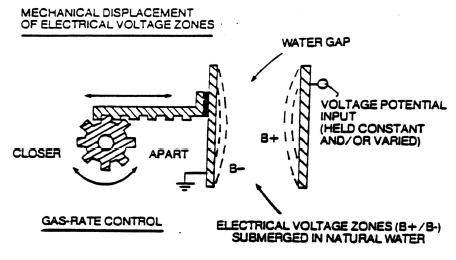 One
technique to control gas production is to physically move the voltage
zones, or plates, closer together, while keeping the voltage potential
constant. Moving the voltage zones closer together causes a greater
electrical force to be applied to the electrical polarization
process.... causing hydrogen to be produced exponentially. One
technique to control gas production is to physically move the voltage
zones, or plates, closer together, while keeping the voltage potential
constant. Moving the voltage zones closer together causes a greater
electrical force to be applied to the electrical polarization
process.... causing hydrogen to be produced exponentially.
.
.
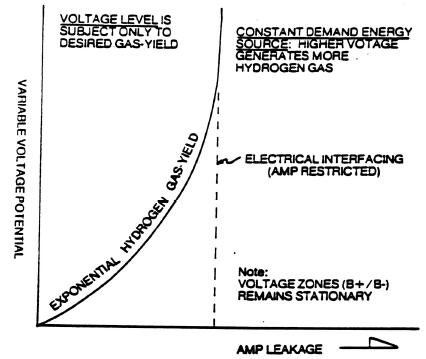 Another
way to control the hydrogen gas production is to maintain the electrical
voltage zones in a fixed position, and increase the intensity of the
electrical voltage potential across the zones. Again, hydrogen gas is
produced exponentially as voltage potential increases. The pulse voltage
frequency potential is used to help restrict amp flow during the
electrical polarization process. Voltage potential may be increased to
any desired level to meet hydrogen gas production on demand. Zero to
20,000 volts range is quite normal at any frequency level. Another
way to control the hydrogen gas production is to maintain the electrical
voltage zones in a fixed position, and increase the intensity of the
electrical voltage potential across the zones. Again, hydrogen gas is
produced exponentially as voltage potential increases. The pulse voltage
frequency potential is used to help restrict amp flow during the
electrical polarization process. Voltage potential may be increased to
any desired level to meet hydrogen gas production on demand. Zero to
20,000 volts range is quite normal at any frequency level.
.
.
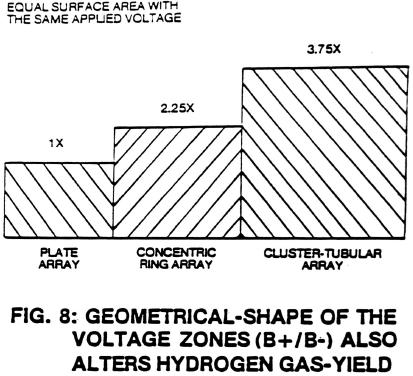 Also,
gas production is greatly manipulated by changing the physical design
characteristics of the voltage zones (voltage zones taking on the shape
of the exciter plate.... skin effect). This includes increasing the size
(height or width or diameter) of the zones, and/or the shape and
configuration of the zones. Also,
gas production is greatly manipulated by changing the physical design
characteristics of the voltage zones (voltage zones taking on the shape
of the exciter plate.... skin effect). This includes increasing the size
(height or width or diameter) of the zones, and/or the shape and
configuration of the zones.
.
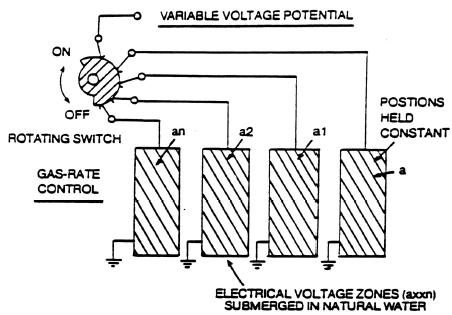
Finally, gas production is greatly manipulated by simply switching on
and off, or pulsing, the electrical voltage zones in a variable,
repetitive manner. The higher the frequency of the voltage pulse, the
greater the production of gas.
.
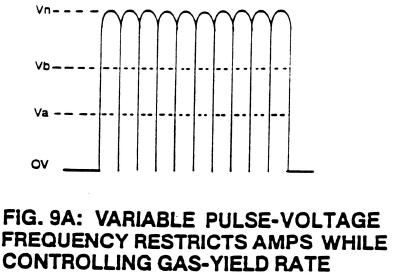
Coupled with this voltage pulsing is "segmentation". The voltage
zones may actually be segmented, with areas of the zones physically
removed at a given point. This reduces gas production. When the segments
are reintroduced inside the Fuel Cell, gas production increases.
.
By combining these voltage potential parameters into a functional
control system, the Fuel Cell now becomes a constant demand generator.
As energy is needed, simply vary the voltage potential parameters to
meet the need. The Fuel Cell, therefore, needs no secondary storage
system since hydrogen is being stored in the safest storage medium know
to man until used..... water. Can you not use water to extinguish a
fire?
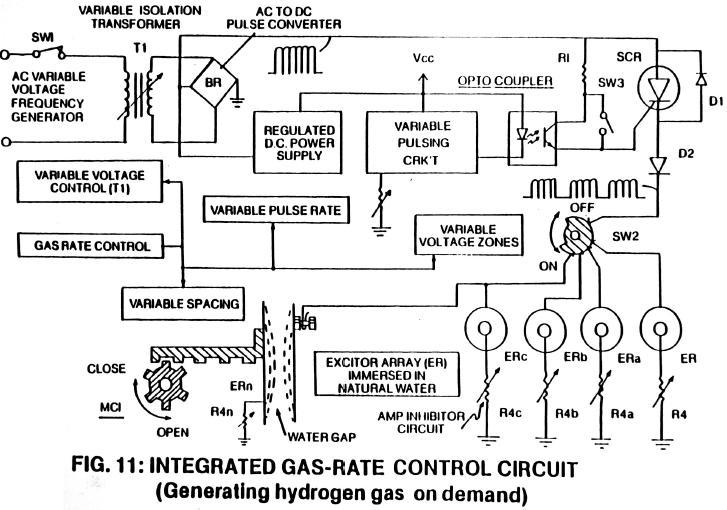
Mega Watt Gas Yield
The previous method of producing hydrogen gas via the application of
voltage potential (pressure or force within an electrical system) is
quite efficient, but there are several advance steps to the ELECTRICAL
POLARIZATION PROCESS that increase hydrogen gas energy production
astronomically from natural water. This is simply don through the use of
a Resonant Cavity Fuel Cell.
Resonant Action and the Phenomena
The Resonant Action within the Fuel Cell occurs in a systematic way.
First an oscillating voltage field, or zone, is formed around a second
oscillating voltage field, or zone, opposite in electrical polarity and
forming a water zone in between. The two oscillating voltage zones are
synchronized into a single repetitive wave form. As the water molecules
are exposed to the reforming voltage zones, the hydrogen atoms become
positively electrically charged while the oxygen atom becomes negative
electrically charged..... electrically polarizing the water molecule.
The pulsating voltage zones also help restrict amp flow during the
electrical polarization process.
Once the electrical polarization phenomenon occurs, the covalent
bonding, or sharing, of electrons between atoms of the water molecule
ceases to exist since the positive electrically charged hydrogen atoms
attract the free floating negative charged electrons while, at the same
time, the negative electrically charged oxygen atom repels the moving
electrons..... thereby stabilizing the energy levels of the atoms....
separating the water molecule into its component parts..... releasing
energy in the form of hydrogen gas and oxygen gas. The opposite polarity
attraction that now exists between the liberated electrically charged
atoms and the stationary electrical voltage zones further aids the
splitting process by imparting a physical impact (particle impact) on
neighboring molecules undergoing the electrical polarization process.
Since the voltage zone that forms the resonant cavity outer wall
momentarily entraps the liberated atoms, the moving atoms are
accelerated and deflected among other molecules being split... causing
compound action. This compounding action continues to increase as more
atoms are being liberated from other water molecules. The repetitive
pulse voltage frequency potential continues the compounding action,
whereas an increase in voltage amplitude speeds up the compounding
action under controlled means. Simply moving liberated atoms back and
forth uniformly through the electrical polarization process in
repetitive manner establishes Resonant Action within the Fuel Cell.
Resonant Action Enhancement
Resonant Action enhancement beyond the influence of pulse
voltage potential is accomplished in several ways. In the area of
electron deflection, the electrically charged atoms moving toward the
water molecules further disrupt the covalent bonding, while at the same
time increasing the electrical charges inside the Fuel Cell during the
electrical polarization process. Increasing the number of electrically
charged atoms within the Fuel Cell directly increases the voltage
charges within the same cell while applied pulse voltage frequency
potential remains the same.... increasing gas yield while power input
remains constant.
In terms of design application, the resonant cavity is multi-tier
with other resonant cavities of similar design in a sequential manner.
As the electrical polarization process occurs, the liberated and
electrically charged atoms are recycled inside the resonant cavity prior
to atom injection into the next cavity-structure undergoing the same
recycling process. The orderly and sequential progression of the moving
charged atoms through the cavity-array increases the voltage charges per
stage since more atoms are being allowed to interact with each
proceeding stage. To increase gas yield even further, additional atom
recycling cavities are affixed to the vertical array to meet a
predetermined gas need.
The interaction of the laser beam or light energy with the liberated
atoms inside the resonant cavity during the electrical polarization
process causes the free floating atoms to either lose or gain
electrons.... causing said atoms to become electrically charged and used
to herein described. The expelling charged atoms are used in conjunction
with the electrical polarization generator to form the regenerative
energy feedback network. This process simply uses the component parts of
water to produce electricity without consuming the charged atoms prior
to gas ignition.
|